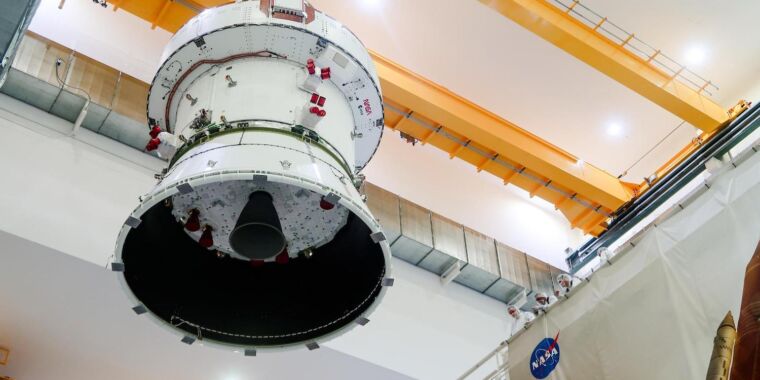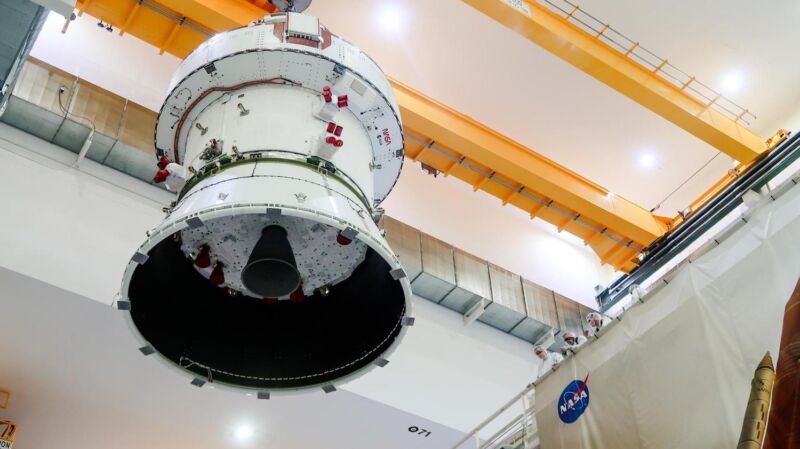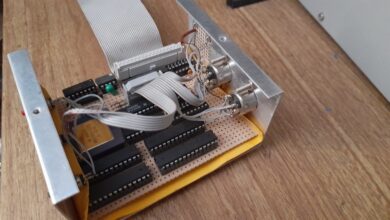NASA wants clarity on Orion heat shield issue before stacking Artemis II rocket


Enlarge / The Orion spacecraft for the Artemis II mission, comprising its crew and service modules, was lifted into a vacuum test chamber at NASA’s Kennedy Space Center in Florida on April 4, 2024.
NASA would like to start stacking the Space Launch System rocket for the Artemis II mission—the first human flight around the Moon since 1972—sometime next month, but the agency’s exploration chief says the milestone could be delayed as engineers continue studying the readiness of the Orion spacecraft’s heat shield.
The heat shield, already installed at the base of the Orion spacecraft, will take the brunt of the heating when the capsule blazes through Earth’s atmosphere at the end of the 10-day mission. On the Artemis I test flight in late 2022, NASA sent an Orion spacecraft to the Moon and back without a crew aboard. The only significant blemish on the test flight was a finding that charred chunks of the heat shield unexpectedly stripped away from the capsule during reentry as temperatures increased to nearly 5,000° Fahrenheit (2,760° Celsius).
The spacecraft safely splashed down, and if any astronauts had been aboard, they would have been fine. However, the inspections of the recovered spacecraft showed divots of heat shield material were missing. The heat shield material, called Avcoat, is designed to erode away in a controlled manner during reentry. Instead, fragments fell off the heat shield that left cavities resembling potholes.
“A lot of work to do”
NASA launched internal and independent investigations to look into the heat shield issue. Catherine Koerner, NASA’s associate administrator for development of exploration systems, told Ars the inquiry remains open.
“We have not made any formal decisions on the forward path yet because we still are doing analysis,” she said. “There are a lot of complications associated with the heat shield, not only with identifying a root cause, but also figuring out a path forward once we identify that root cause.”
This is a complicated thermodynamic and aerodynamic problem, with engineers studying the combined effects of heating and air resistance as the Orion spacecraft dives deeper into the atmosphere. Victor Glover, the pilot of the Artemis II mission, told Ars earlier this year that ground testing and analyses can only go so far, and some of the dynamics may not be fully understood without more flight data.
Commander Reid Wiseman, mission specialist Christina Koch, and Canadian astronaut Jeremy Hansen will join Glover on the Artemis II mission. They will fly around the far side of the Moon inside the Orion capsule after lifting off from NASA’s Kennedy Space Center in Florida on a Space Launch System (SLS) rocket. Artemis II will pave the way for future landing missions to deliver astronauts to the Moon’s south pole.
But it’s taking longer than NASA officials would have liked to complete the Orion heat shield investigation. Koerner said she didn’t want to estimate how much longer it would take for NASA to come to a decision on what, if anything, to change on the Artemis II mission to reduce the risk to the astronauts.
“The best way to ensure crew safety on any activity, but especially this one in particular, is to make sure that they understand that they’re doing this—the focus of this investigation and the forward path—with crew safety in mind, and not with schedule pressure or any other kind of external pressure from stakeholders,” she said.
Potential solutions to the heat shield issue for Artemis II include altering the spacecraft’s trajectory during reentry or making changes to the heat shield itself. The latter option would require partially disassembling the Orion spacecraft at NASA’s Kennedy Space Center, something that would probably delay the launch date from September 2025 until 2027 at the earliest. Another alternative could be to do nothing and fly the Artemis II mission as is.
“The entire trade space is open,” Koerner said. “But as far as the actual Artemis II mission, right now, we’re still holding to the September ’25 launch date, knowing that we have still a lot of work to do to close out the heat shield investigation.”



